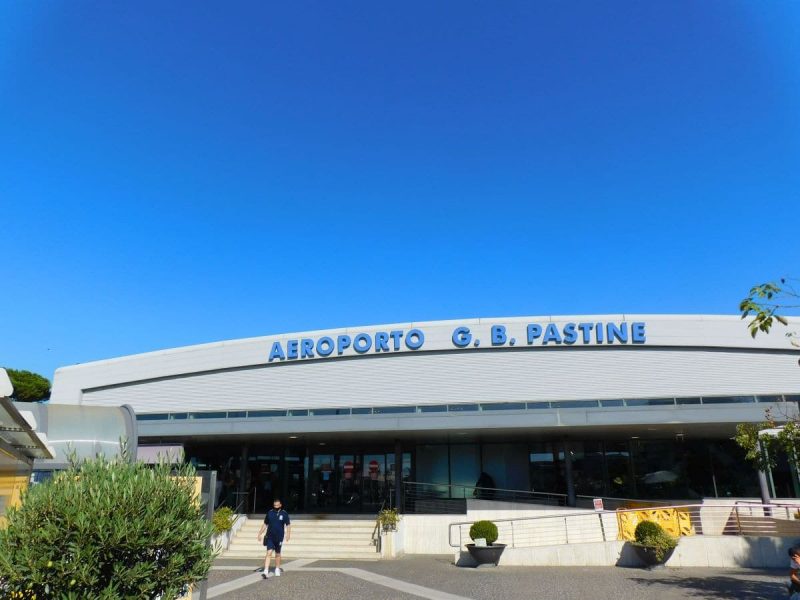The Italian capital Rome has two international airports, which could hardly be more different. What the two airports have in common is that they are operated by Aeroporti di Roma, a subsidiary of the Atlantia group of the Benetton family.
The Rome Fiumicino carries the IATA code FCO and is the larger of the two airports and was officially opened on October 20, 1960. Since then, this airport has been expanded into a major airport. There are currently two large terminal buildings: Terminals 1 and 3. Terminal 2, which was previously mainly used by low-cost travelers, was demolished in 2018.
The effects of the corona pandemic are clearly noticeable in Fiumicino. Terminal 1 is currently only used for check-in and security control. Then it goes airside over a connecting bridge to Terminal 3, where the aircraft is then boarded. Annoying for frequent flyers: In the Schengen area - in contrast to non-Schengen - all lounges are still closed. Otherwise, the gastronomic offer is on the back burner. For several years now, FCO has also had a satellite terminal in Gate Area E.
Only a few airlines are currently using the check-in counters in Terminal 1. As a result, the vast majority of the counters, which are often branded in Alitalia's colors, are orphaned. In some cases, they also have a small layer of dust. It is currently not foreseeable when these will be needed again. However, the FCO cannot leave Terminal 1 completely closed because the capacity in Terminal 3 is insufficient with regard to check-in and security control.

Tower at Rome Fiumicino Airport (Photo: Jan Gruber). 
Rome Fiumicino Airport (Photo: Jan Gruber). 
Rome Fiumicino Airport (Photo: Jan Gruber). 
Rome Fiumicino Airport (Photo: Jan Gruber). 
Rome Fiumicino Airport (Photo: Jan Gruber). 
Rome Fiumicino Airport (Photo: Jan Gruber). 
Rome Fiumicino Airport (Photo: Jan Gruber). 
Alitalia counter at Rome Fiumicino Airport (Photo: Jan Gruber). 
Rome Fiumicino Airport (Photo: Jan Gruber). 
Tower at Rome Fiumicino Airport (Photo: Jan Gruber).
Fiumicino is used by pretty much all airlines that have Rome in their route network. One of the ways to get to the city center of the Italian capital is by paid shuttle buses that run from the bus station next to Terminal 3. There is also a not very cheap train connection.
If you find the Colosseum and St. Peter's Square uninteresting and prefer to go swimming in the Mediterranean, the FCO is ideal. There are regular buses to Fiumicino. A few minutes' drive takes you to large sandy beaches. There are also many beach cafes. Alternatively, rental cars or vehicles from the car sharing provider Share Now can be used. The latter are likely to be of interest for shorter trips, as longer rents are more expensive than traditional providers.
Less offer, but closer to the city: Giovan Battista Pastine Airport (Ciampino)
The Rome Ciampino Airport (CIA), which opened in 1916, was the most important airport in the region until Alitalia moved to Fiumicino. For decades it was a military airport with civilian use. Ciampino has only been controlled by the ENAC aviation authority since 2013. This does not apply to the military parts that are still in use.
Before Fiumicino opened, Ciampino was one of the busiest airports in Europe. That changed suddenly and for decades the passenger terminal was only used very little. In the early 2000s, Ryanair, Easyjet and other low-cost airlines set up shop. Gradually, the number of passengers rose sharply again. In 2019 there were 5.879.496, significantly more than in the "high times" before the opening of the FCO.

Rome Ciampino Airport (Photo: Jan Gruber). 
Rome Ciampino Airport (Photo: Jan Gruber). 
Rome Ciampino Airport (Photo: Jan Gruber). 
Rome Ciampino Airport (Photo: Jan Gruber). 
Ryanair at Rome Ciampino Airport (Photo: Jan Gruber). 
Rome Ciampino Airport (Photo: Jan Gruber). 
Rome Ciampino Airport (Photo: Jan Gruber). 
Rome Ciampino Airport (Photo: Jan Gruber). 
Rome Ciampino Airport (Photo: Jan Gruber).
The consequence of the growth is that the aging terminal had to be modernized and expanded. However, it still has a bit of the flair of an aging airport. In return, passengers benefit from comparatively very short distances. Ciampino is much closer to downtown Rome than the larger Fiumicino Airport. Chargeable shuttle buses and a train connection are available. The latter is not without a change, because first a shuttle bus to Ciampino train station has to be used. However, this is included in the ticket price.
Ryanair and Wizz Air sit on CIA slots
Currently, the CIA is used almost exclusively by Ryanair and Wizz Air. Easyjet has moved all flights to Fiumicino. Occasionally, other airlines also fly from Ciampino, but the tail fins of the two lowcosters mentioned dominate. It is therefore not surprising that the infrastructure has been heavily adapted to the ideas of low-cost airlines.
It's not as if Ciampino, apart from Ryanair and Wizz Air, doesn't want to use Ciampino, but there are almost no free slots. The two providers mentioned have almost all take-off and landing rights, as these are severely limited to a maximum of 65 per day. On the one hand, this is intended to prevent a “Linate effect” and, on the other hand, there has been strong resistance from local residents since the early 2000s.
Military flights, general aviation and freight connections are excluded from this restriction. In Ciampino, among others, DHL, FedEx and UPS have bases. This means that larger cargo aircraft can occasionally be encountered, with the Boeing 757 machine type currently dominating.
At Giovan Battista Pastine Airport there is basically a lounge, but it is located in the General Aviation Terminal. There is currently no exclusive waiting area available in the terminal, which is used by normal passengers. This is likely to be related to the strong focus on low-cost air travelers.
For day trips: CIA and FCO can be combined
For day trips to the Italian capital, the airports Ciampino and Fiumicino can easily be "combined". For example, flying to the CIA in the morning and back home from the FCO in the evening - or vice versa. When booking tickets to the city, you should only make sure that you buy the tickets from / to the correct airport.
Tip: The Sit Shuttlebus provider sells flexible tickets. This means that you can use any company bus on the booked route on the day you book and you are not “pegged” at any time. The tickets can be bought online, at the counters and from the bus drivers or from the passenger attendants.
Tickets for public transport within Rome are available from machines and ticket counters. For some time now it has also been possible to travel “ticketless”. To do this, you put on your NFC-enabled debit or credit card before entering the metro or after getting on the bus or tram. A single ticket is then debited, whereby the 100-minute validity is taken into account when changing and the payment method is not charged again. In the event of an inspection, you simply show your debit or credit card and the inspector can then use his device to determine that you have paid properly.
Finally, there is a general problem in the Italian capital: pickpockets. These are up to mischief almost everywhere, regardless of whether at the Termini train station or at sights. The local police warn on posters and with the help of loudspeaker announcements. Therefore, you should always keep an eye on your valuables and bags, because thieves are lurking almost everywhere for their chance.

Colosseum Rome (Photo: Jan Gruber). 
Colosseum Rome (Photo: Jan Gruber). 
Colosseum Rome (Photo: Jan Gruber). 
Colosseum Rome (Photo: Jan Gruber). 

Petersplatz Vatican (Photo: Jan Gruber). 
Petersplatz Vatican (Photo: Jan Gruber). 
Flag of the Vatican (Photo: Jan Gruber). 
Petersplatz Vatican (Photo: Jan Gruber). 
Colosseum Rome (Photo: Jan Gruber).







 trail (for them it's free to use)
trail (for them it's free to use)